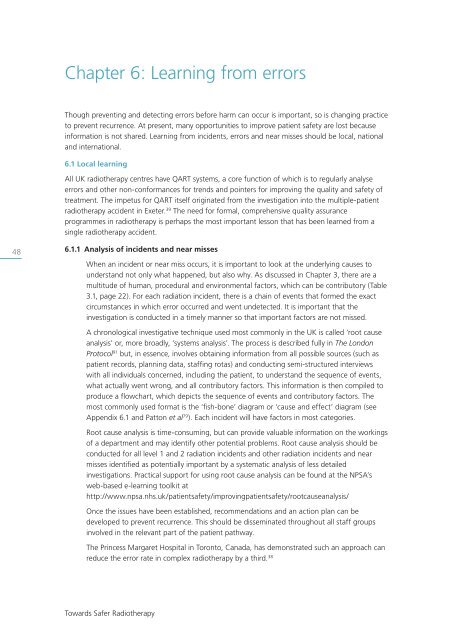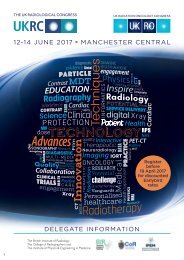Towards Safer Radiotherapy
Towards Safer Radiotherapy
Towards Safer Radiotherapy
Create successful ePaper yourself
Turn your PDF publications into a flip-book with our unique Google optimized e-Paper software.
Chapter 6: Learning from errors<br />
Though preventing and detecting errors before harm can occur is important, so is changing practice<br />
to prevent recurrence. At present, many opportunities to improve patient safety are lost because<br />
information is not shared. Learning from incidents, errors and near misses should be local, national<br />
and international.<br />
6.1 Local learning<br />
All UK radiotherapy centres have QART systems, a core function of which is to regularly analyse<br />
errors and other non-conformances for trends and pointers for improving the quality and safety of<br />
treatment. The impetus for QART itself originated from the investigation into the multiple-patient<br />
radiotherapy accident in Exeter. 39 The need for formal, comprehensive quality assurance<br />
programmes in radiotherapy is perhaps the most important lesson that has been learned from a<br />
single radiotherapy accident.<br />
48<br />
6.1.1 Analysis of incidents and near misses<br />
When an incident or near miss occurs, it is important to look at the underlying causes to<br />
understand not only what happened, but also why. As discussed in Chapter 3, there are a<br />
multitude of human, procedural and environmental factors, which can be contributory (Table<br />
3.1, page 22). For each radiation incident, there is a chain of events that formed the exact<br />
circumstances in which error occurred and went undetected. It is important that the<br />
investigation is conducted in a timely manner so that important factors are not missed.<br />
A chronological investigative technique used most commonly in the UK is called ‘root cause<br />
analysis’ or, more broadly, ‘systems analysis’. The process is described fully in The London<br />
Protocol 91 but, in essence, involves obtaining information from all possible sources (such as<br />
patient records, planning data, staffing rotas) and conducting semi-structured interviews<br />
with all individuals concerned, including the patient, to understand the sequence of events,<br />
what actually went wrong, and all contributory factors. This information is then compiled to<br />
produce a flowchart, which depicts the sequence of events and contributory factors. The<br />
most commonly used format is the ‘fish-bone’ diagram or ‘cause and effect’ diagram (see<br />
Appendix 6.1 and Patton et al 79 ). Each incident will have factors in most categories.<br />
Root cause analysis is time-consuming, but can provide valuable information on the workings<br />
of a department and may identify other potential problems. Root cause analysis should be<br />
conducted for all level 1 and 2 radiation incidents and other radiation incidents and near<br />
misses identified as potentially important by a systematic analysis of less detailed<br />
investigations. Practical support for using root cause analysis can be found at the NPSA’s<br />
web-based e-learning toolkit at<br />
http://www.npsa.nhs.uk/patientsafety/improvingpatientsafety/rootcauseanalysis/<br />
Once the issues have been established, recommendations and an action plan can be<br />
developed to prevent recurrence. This should be disseminated throughout all staff groups<br />
involved in the relevant part of the patient pathway.<br />
The Princess Margaret Hospital in Toronto, Canada, has demonstrated such an approach can<br />
reduce the error rate in complex radiotherapy by a third. 38<br />
<strong>Towards</strong> <strong>Safer</strong> <strong>Radiotherapy</strong>



